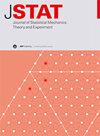动态渗流中的临界加速
IF 1.9
3区 物理与天体物理
Q2 MECHANICS
Journal of Statistical Mechanics: Theory and Experiment
Pub Date : 2024-07-30
DOI:10.1088/1742-5468/ad6137
引用次数: 0
摘要
我们研究了离散时间动态渗滤中原点处集群大小的自相关时间。我们重点研究了二叉树和高维环,结果表明,在这两种情况下,自相关时间在次临界机制下与体积呈线性关系,但在临界时与体积呈严格的次线性关系。这就严格确定了在这些模型中,原点处的簇大小表现出临界加速。证明涉及控制相关的傅立叶系数。在二叉树的情况下,这些傅里叶系数是明确研究的,而对于高维环,我们采用了施拉姆和斯蒂夫在噪声敏感性背景下引入的随机算法论证。本文章由计算机程序翻译,如有差异,请以英文原文为准。
Critical speeding-up in dynamical percolation
We study the autocorrelation time of the size of the cluster at the origin in discrete-time dynamical percolation. We focus on binary trees and high-dimensional tori, and show in both cases that this autocorrelation time is linear in the volume in the subcritical regime, but strictly sublinear in the volume at criticality. This establishes rigorously that the cluster size at the origin in these models exhibits critical speeding-up. The proofs involve controlling relevant Fourier coefficients. In the case of binary trees, these Fourier coefficients are studied explicitly, while for high-dimensional tori we employ a randomised algorithm argument introduced by Schramm and Steif in the context of noise sensitivity.
求助全文
通过发布文献求助,成功后即可免费获取论文全文。
去求助
来源期刊
CiteScore
4.50
自引率
12.50%
发文量
210
审稿时长
1.0 months
期刊介绍:
JSTAT is targeted to a broad community interested in different aspects of statistical physics, which are roughly defined by the fields represented in the conferences called ''Statistical Physics''. Submissions from experimentalists working on all the topics which have some ''connection to statistical physics are also strongly encouraged.
The journal covers different topics which correspond to the following keyword sections.
1. Quantum statistical physics, condensed matter, integrable systems
Scientific Directors: Eduardo Fradkin and Giuseppe Mussardo
2. Classical statistical mechanics, equilibrium and non-equilibrium
Scientific Directors: David Mukamel, Matteo Marsili and Giuseppe Mussardo
3. Disordered systems, classical and quantum
Scientific Directors: Eduardo Fradkin and Riccardo Zecchina
4. Interdisciplinary statistical mechanics
Scientific Directors: Matteo Marsili and Riccardo Zecchina
5. Biological modelling and information
Scientific Directors: Matteo Marsili, William Bialek and Riccardo Zecchina

 求助内容:
求助内容: 应助结果提醒方式:
应助结果提醒方式:


